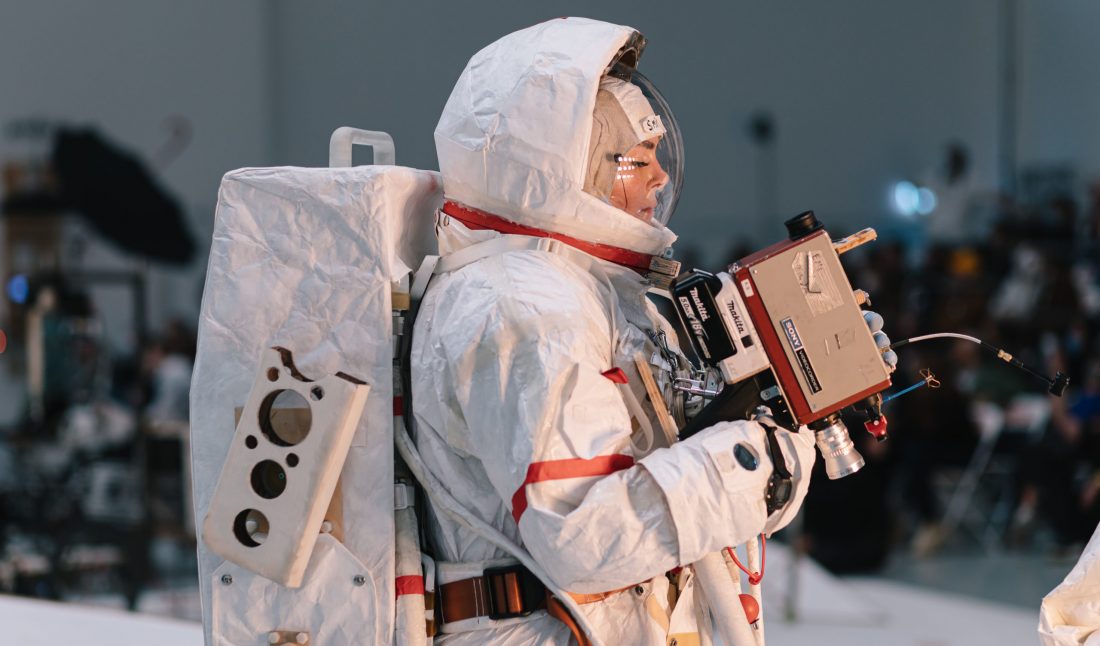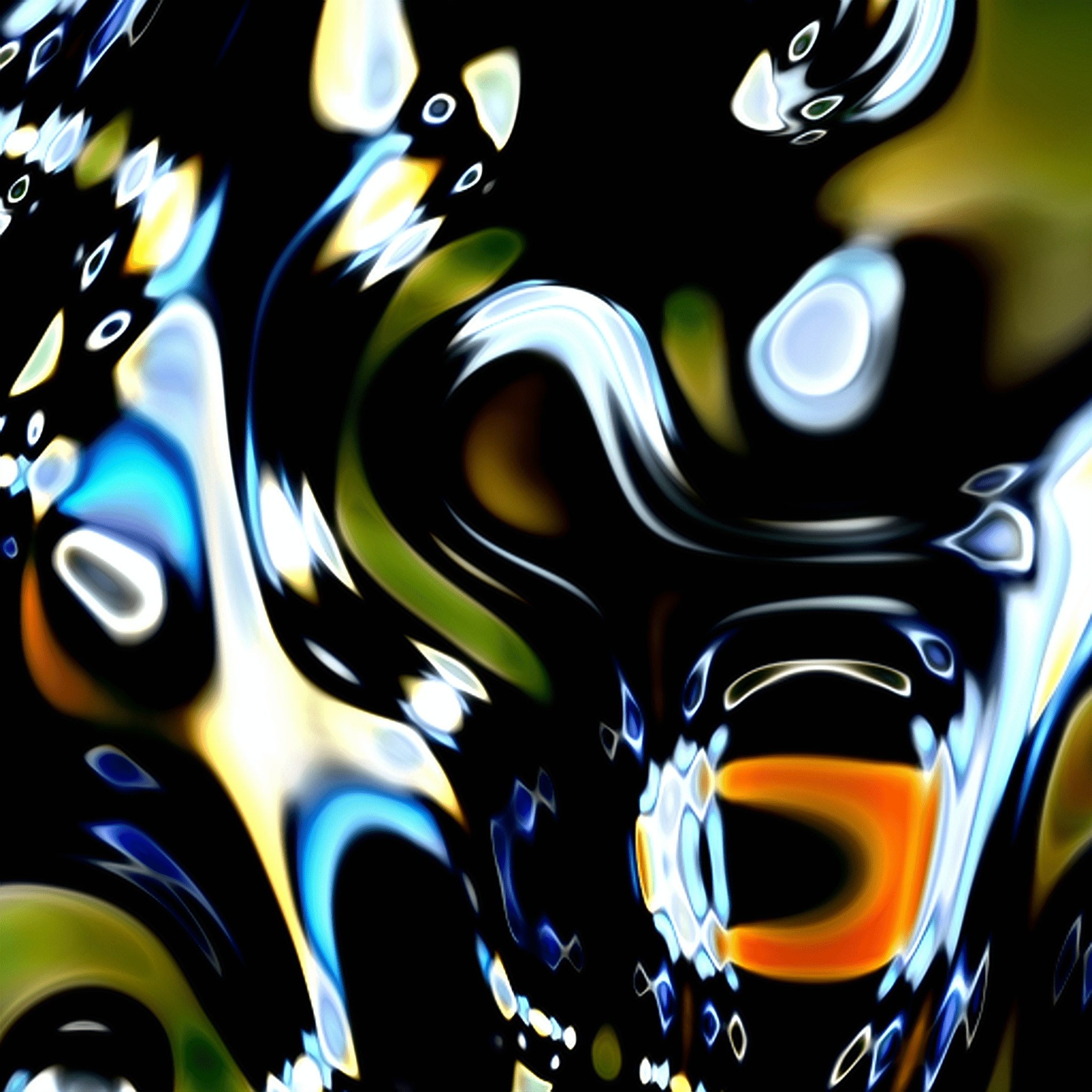Interviewing Tom Sachs has been on my bucket list for a while now. I feel so connected to his artistic interests, from his obsession with space to his appreciation for Japanese tea ceremonies. They are not obvious associations, which is why the first time I came across his art it felt like someone had taken everything I love and somehow merged it.
His artistic philosophy breaks all of the walls of modern society, from capitalistic consumerism to religion. I love how he redefines art through experience. His exhibitions are somewhere between craft and technology, the archaic and the modern, the past and the future.
In our interview we talked about his recent mission to Vesta for “Space Program: Rare Earths,” looking for resources to be used here on Earth, at the Deichtorhallen Hamburg. Then about his launch of “Rocket Factory” in Paris at Palais de Tokyo, and finally, “Exchange” at Thaddaeus Ropac Gallery, following his 2018 “Swiss Passport Office” project, where I first met him.
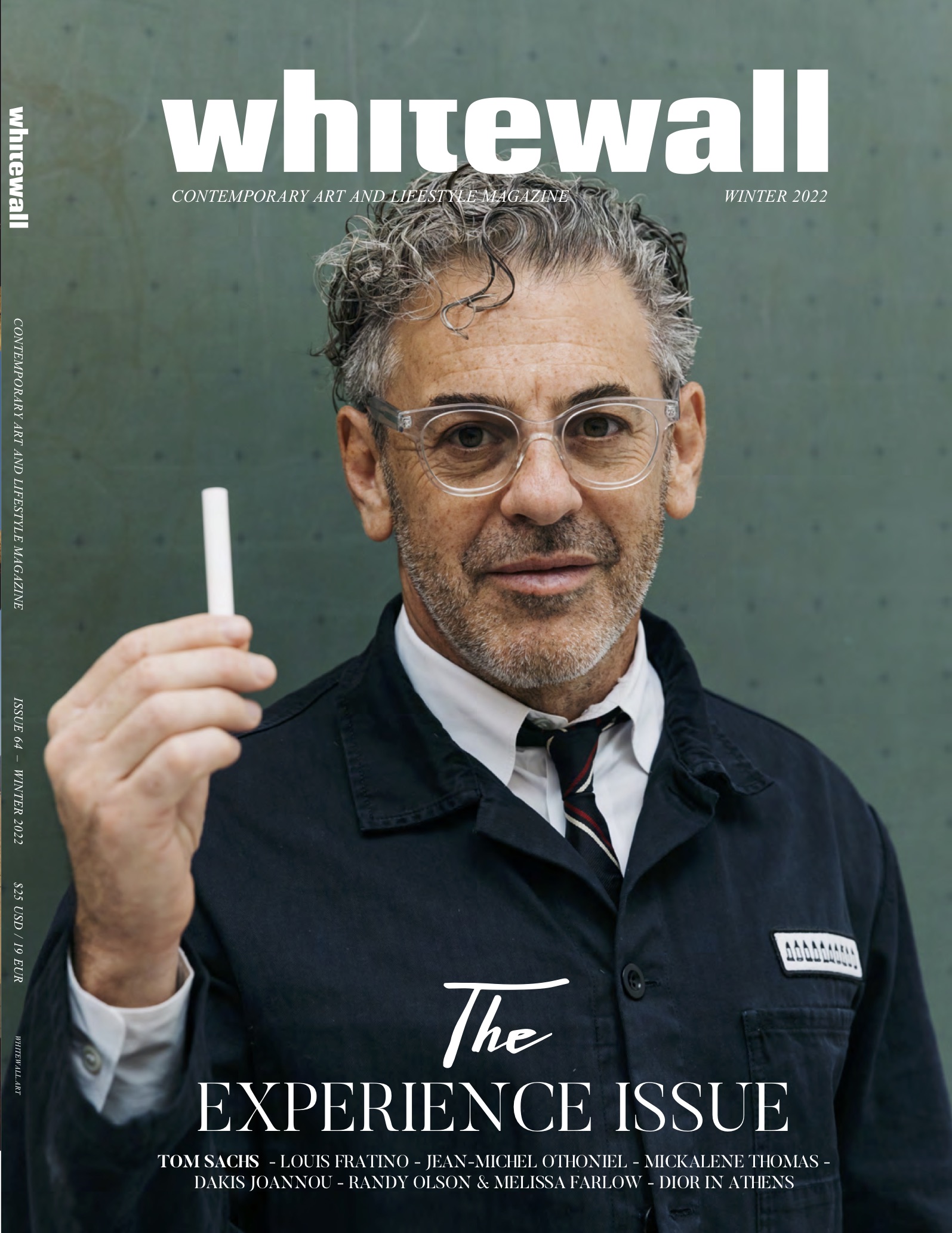 Tom Sachs portrait by Karl Hab.
Tom Sachs portrait by Karl Hab.
GINEVRA ROSSINI: It’s an honor and a pleasure to be interviewing you, and let’s dive right into it. I wanted to ask you a bit about the about the “Space Program: Rare Earths” and your mission to Vesta. Can you elaborate on your fourth mission of the space program?
TOM SACHS: This space program, the mission was a complete and total success. We had some uncertainty, but we were prepared, and so we went to this other world because we were running low on rare earth elements needed to feed our addiction. Astronauts landed on Vesta and after some difficulties, they found some elements.
They refined them, and they made a golden idol that they brought back to Earth for us to continue to worship. It took nine hours—it was a colossal pain in the ass. But we succeeded, and in the process, I think we got a little bit in touch with our place in the universe. How small and precious and rare and brief our lives are and yet unimportant we are in the cosmos, yet how precious the moments in our lives can be.
GR: That shift in perspective that you get from maybe seeing the Earth as like a tiny blue dot, as they say, no? “Overview effect,” they call it, astronauts when they come back.
So where do you where do you see your space program headed after this mission? You went to be Vesta, the closest asteroid and the brightest one. Where do you see the space program headed after this?
TS: I think we go to the infinite beyond. We’ve explored this solar system. There’s much more to explore. Two things. We go beyond the solar system into the infinite. I think we go into our death. I don’t want to say “our death” because that’s synonymous with the trauma of ending our life, but I think really what I mean by that is we go to a place beyond our lives, where we connect to a dimension beyond the realm of time and space. To the infinite.
In quantum physics, they talk about some pretty complex, heady stuff about, like, you generally get it down to the molecular level or the subatomic level; you know that every atom is exactly the same. There are some pretty easy conclusions to make about the nature of time if you start looking at how quickly these things move, and maybe there’s a place where time doesn’t exist. But that’s another dimension, that may be occurring, but at the same time this moment in our short lives, where we’re here, fairly successful, we reproduce, from a Darwinian sense, and we continue with our place in this life and we draw a lot of importance to that. And we should because we don’t have much time to do with it.
But I think probably I’m interested in exploring a dimension beyond this time and space and life here on Earth, like the raw sensuality of being a human being.
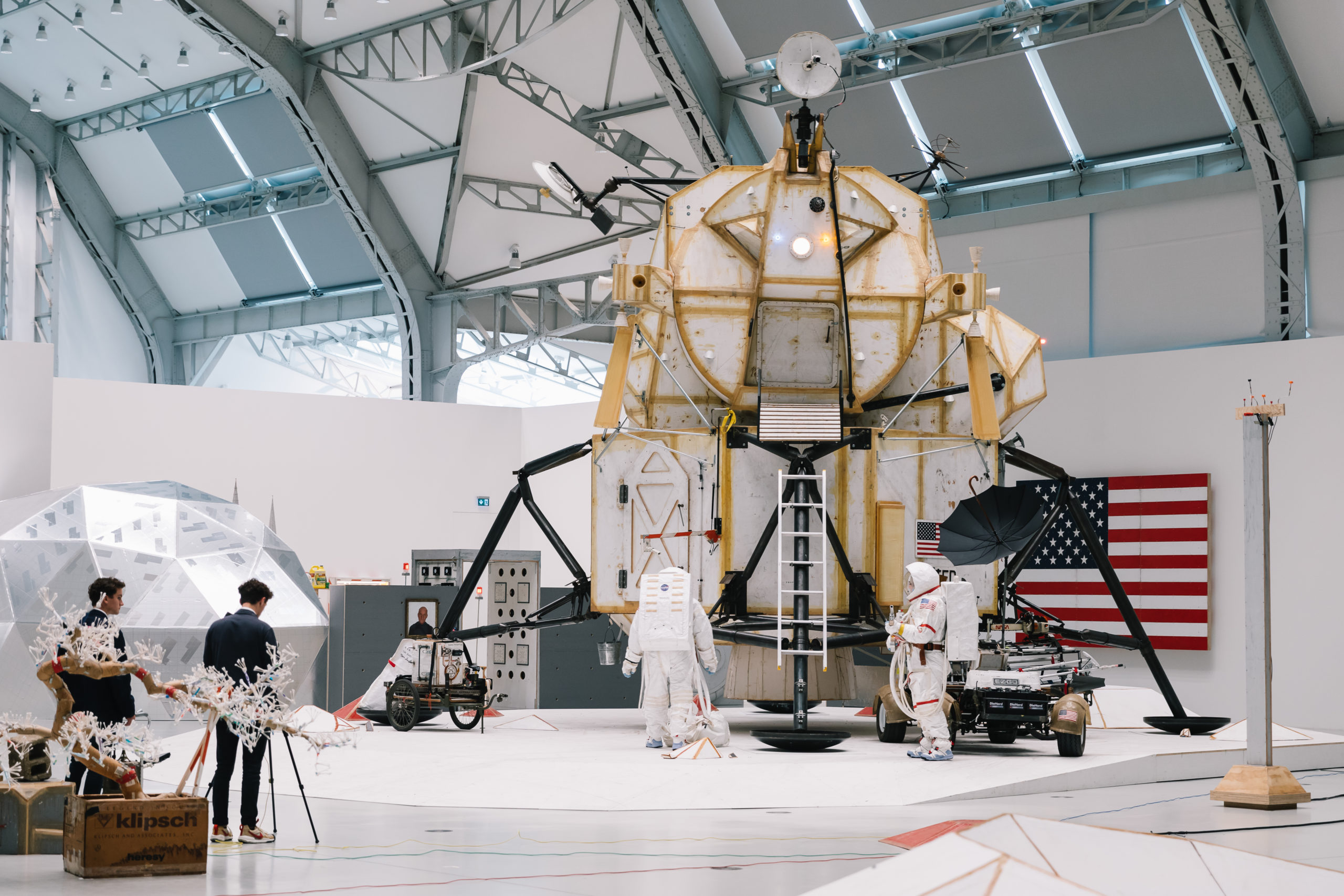 Live performance of Tom Sachs’s “SPACE PROGRAM: RARE EARTHS” (September 19, 2021—April 10, 2022) at Deichtorhallen Hamburg, photo by Karl Hab.
Live performance of Tom Sachs’s “SPACE PROGRAM: RARE EARTHS” (September 19, 2021—April 10, 2022) at Deichtorhallen Hamburg, photo by Karl Hab.
GR: When visitors arrive at the space program you put them through an indoctrination process, correct?
TS: Yeah.
GR: Doctrine assumes that there is a religion. So how does religion fit in with what you’re talking about?
TS: You know, we are a religious organization; the studio is a religion. I would even say that we’re not a religion; we are more of a cult. And Ginevra, you are a member of our cult.
GR: Of course I am.
TS: Because you follow us on Instagram. And I’m a member of your cult because I follow you. We are members of each other’s cults. And we are all in different degrees, some of us are obsessed, some of us are casual cult members, some of us follow because we believe, some of us follow because we want to believe, some of us follow because we want others to believe that we believe. There are many, many ways in and out, and it doesn’t really matter what they are to me. My agenda is teaching the values of the studio.
GR: Are you talking about 10 Bullets?
TS: Yes, absolutely. I think 10 Bullets is kind of the beginning, but I mean, our Discord channel, our Instagram or Twitter, all the movies that we make on YouTube. That’s all our indoctrination. That’s our scripture.
GR: I think every company will have its own bullet program. It would be so much more efficient—everything would work. But I’m also curious, what are the tasks that you make the visitors undergo in order to be indoctrinated? What do they have to do?
TS: So, if you want to become indoctrinated, if you want to become one of us, it starts with watching 10 Bullets. That’s the first move, and all the other studio movies. Because that’s the most passive, like you can do it at home, you can do it on your phone, it’s free, it’s unlimited, you don’t need to be there. But let’s just say that you like that you want to take the next step. You come to the Indoctrination Center, you fill out an application, and then you sort screws. We have a gigantic pile of screws called logjam, and these are all the screws that we use to make the space program.
I’m going to take you with me and show you because I’m in the studio now. This is one of my hardware stores. This is logjam, this drawer. These are all screws that are too valuable to throw away but not valuable enough to sort in their proper containers. So this is an intermediate state. This chaos, right, is like the gases in a galaxy that coagulate over millennia to become a gaseous planet, a comet, and maybe over another few billion years develop a rocky core. And then maybe another billion years go by and this core develops an environment, and then another billion years go by and this environment supports life that grows into slime, and then another billion years go by and that slime evolves into creatures, like you and me, who are talking about slime.
So from entropy and chaos come life gradually and then, of course, everything then devolves back into chaos. But what we’re interested in doing is taking a little bit of this, bring it together using our hands, because I believe that we’re that we’re sensual beings and getting your hands dirty is a way of learning.
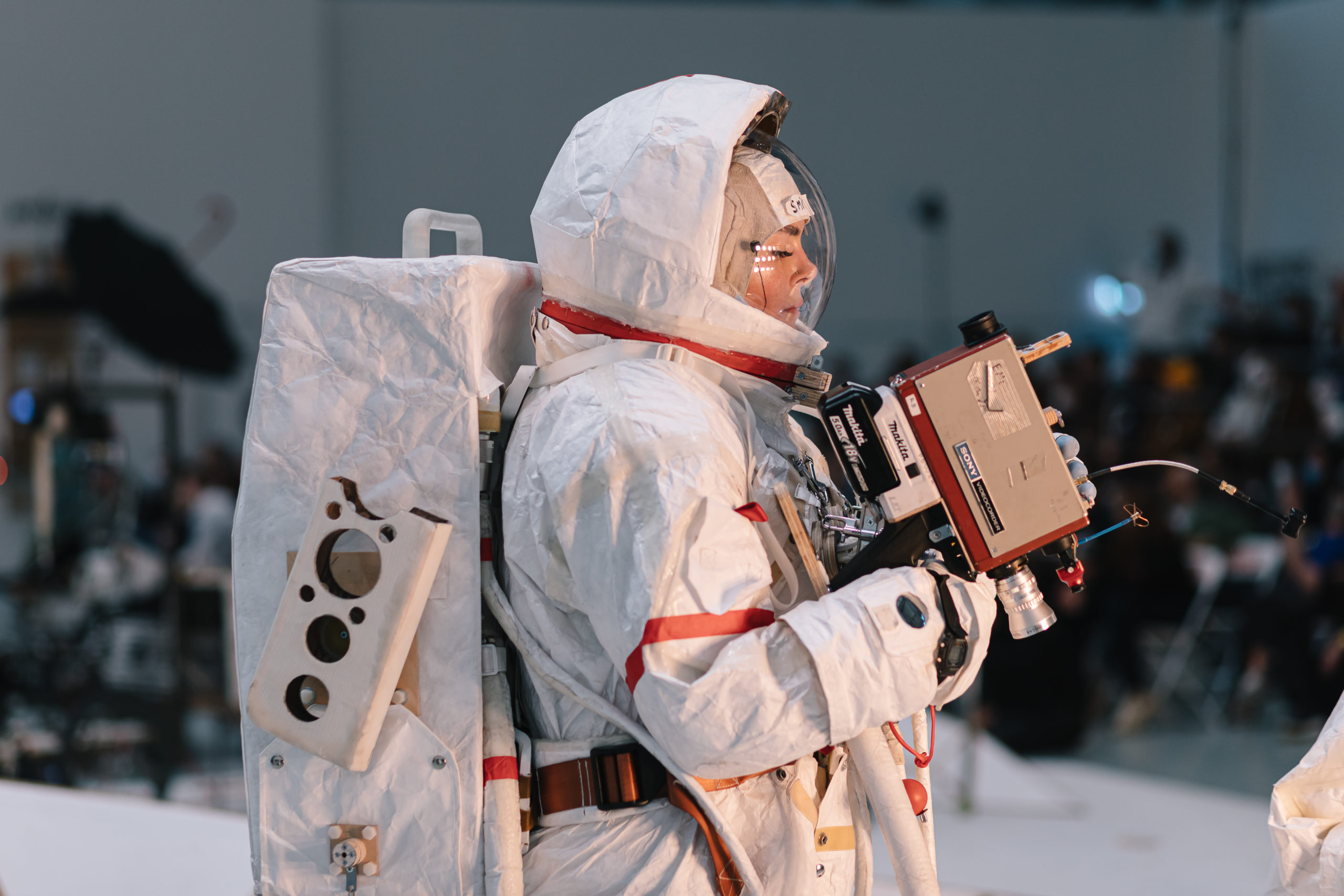 Live performance of Tom Sachs’s “SPACE PROGRAM: RARE EARTHS” (September 19, 2021—April 10, 2022) at Deichtorhallen Hamburg, photo by Karl Hab.
Live performance of Tom Sachs’s “SPACE PROGRAM: RARE EARTHS” (September 19, 2021—April 10, 2022) at Deichtorhallen Hamburg, photo by Karl Hab.
GR: So, the manual act of putting your focus on the present moment and doing something manual.
TS: I think it’s the essential because—and I think that you can really relate to this because you love stuff and being outdoors, and are a sensualist—I think we all are, some of us more than others, but touch is the foundation of the human condition. And through touch, whether it’s like something very soft like an animal or another person or something really hard like a metal screw—you know in school, we learn about logic, but we don’t learn about sensuality and touch and intuition. And I think that’s what we’re trying to teach here. And we don’t learn to work with our hands. We learn to look work away from our hands. We have calluses on our fingers from touching screens, not from touching materials.
GR: I wanted to talk to you about the “Rocket Factory.” You said that for this project what excited you the most is bridging the metaverse with the physical world. How have you seen the connections being made since the debut of “Rocket Factory”?
TS: Thank you for asking. To me the metaverse and plywood space meet space are the same. It’s not real world versus digital world. Digital world is real—it’s just in a different dimension. And a project like “Rocket Factory” could only exist in the metaverse because with a thousand components, you can only really access them through a searching filter that a computer allows.
I’m really proud of “Rocket Factory” because we’ve been able to have equal parts in physical space and the metaverse. And that’s something that’s always important to me. It took a couple years for me to really get in touch with a way to make something in this space that was authentic to the studio because we’re sensualists and because we do things by hand. We wanted to find something that was authentic, and I think we did it. I’ve been working in this space now on this project for a couple of months and it’s growing. We’re getting ready to launch phase two in November.
Wherever you, are you’ll be able to be there because it’s a metaverse project. But in New York during an NFT New York we’re going to be launching some rockets and some physical space stuff. I would say this to you and to your readers, get a rocket before November, if you want to get involved. Because there’ll be new functionality released in November and things will change, And maybe you don’t want to publish that, maybe that’s just for you and your friends, but I would say just get the cheapest rocket you can—it doesn’t matter which one. Just get involved.
GR: You just came back from “Exchange,” your 24-hour event at Thaddaeus Ropac gallery in Paris. What was your initial idea for “Exchange” and how did your experience with—where we met—the 2018 “Swiss Passport Office” influence it?
TS: In 2018 we made a “Swiss Passport Office.” And that was a way, for 20 euros, you could get a Swiss passport. And part of that was my frustration about Brexit. Where we had worked so hard to unify the people of Europe and then it took a step in the wrong direction. If we are all one people, and we’re all working toward the same goal, we will have less conflict. Especially as we have increased transparency and communication, which is one of the things that maybe could be good about all this communication, transparency.
But borders are created to control people for profit by governments and the corporations, who control them. So for me, making arguably the most prestigious passport available to everyone for 20 euros was a way of making the world not the way it is, but the way I want the world to be.
The “Exchange” project is a sequel to this. It’s Swiss banking. It’s about money. Money is an illusion by which we all live and die. It’s real whether you’re trading in shells or coins or paper or gold or paper that represents gold. Like there’s no difference between a one-dollar note and one-hundred-dollar note, it’s just we believe in the zeroes and we know it’s worth 100 times. And you can buy real things with it. It’s an illusion that is one hundred percent concrete. So, as I discovered the blockchain, I began to understand the potential of taking the power away from Chase Bank and Deutsche Bank into the hands of individuals.
GR: Democratizing it?
TS: Yeah, decentralizing it, and it’s a pretty exciting possibility and we’re on the brink of a revolution, we may or may not win. But if we all participate, we will win, and my role as an individual is to use my best asset. I have money, but I don’t have that much. No one really does. No one person has enough, even the richest people; what we need is everyone to participate. And the way we can participate is by doing projects in this space. So the best thing I can do as an individual is do my art projects in this space and use the metaverse.
So in our project you put down 20 euros, you get five beads, you trade five beads for a coin you put that coin in an automated teller machine, out comes a chocolate bullion, a Reese’s candy bar. You open that, there’s a QR code. You scan it and you get two hundred chocolate bullion tokens in your digital wallet, SLP tokens.
Now, we did this for 24 hours, what wasn’t sold after 24 hours was burned, so from four million tokens we’re down to, I think, 800,000, or maybe less—I don’t have the exact number to do the math. And there are still some tokens available, but they’re only in these blocks. And they’re available at the gallery. Now these tokens might not be worth anything, they were certainly worth the experience of going through this trade because there is value in all the work that was exchanged, in all the time that took to go from euros to beads to coins to chocolate to digital token. If you go through that, it never takes you time to process that. There’s labor in that, there’s art value in going through all of that. But the idea of us taking it back for ourselves is very important. I think we have to, we have to do this, we have to try.
In a way, this 24 hours was really just a game. Some people made money, some people lost money, some people came away with digital tokens, which maybe are worthless, but maybe they’ll be transformed into an NFT, and if that happens, and they get traded, some people might get very rich, as we know.
It doesn’t matter to me what happens. What matters is that people are engaged and begin to understand this process a little bit more—that was the goal.
GR: It seems like throughout all of your programs, the common denominator is the community creation. Why is this so central to your work?
TS: Well, I think that’s all we do. That’s all that people do is we build community. Even when a writer living alone working in her office writes a book, it gets the ideas out there in the world. You don’t have to physically be with someone. There are lots of ways of building community.
You can do it on Instagram, you can do it through a magazine article. Today we’re building a community together.
I’m interested in building a community of people that want to believe in the way I see the world or, more importantly, want to learn about it and change the way they think because I’m always looking to change the way I think to have a broader understanding of the world, broader and deeper. So deeper into my world but broader into other people’s world simultaneously.
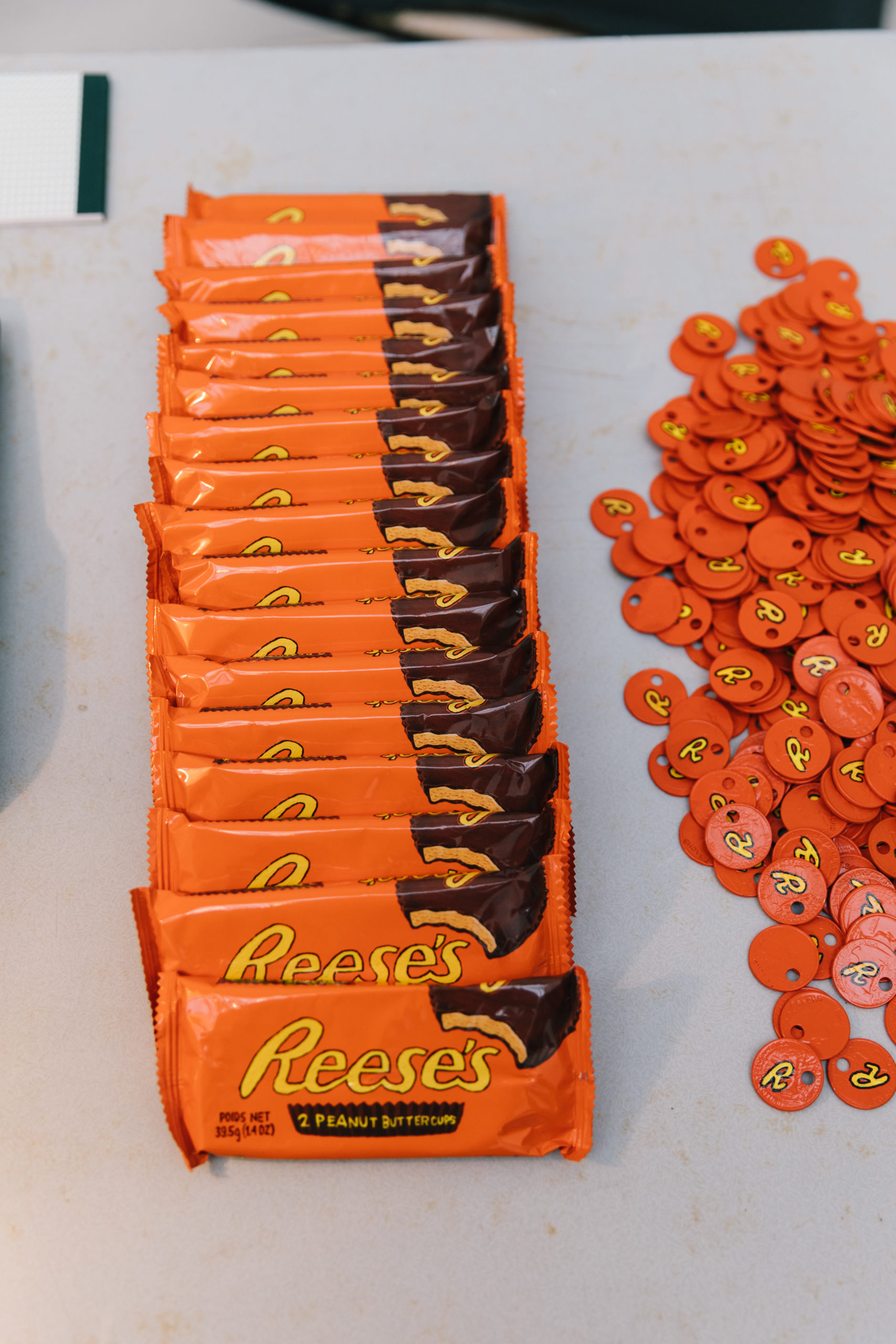 Installation view of “Exchange” by Tom Sachs at Thaddaeus Ropac in Paris (October 2-3, 2021), photo by Karl Hab.
Installation view of “Exchange” by Tom Sachs at Thaddaeus Ropac in Paris (October 2-3, 2021), photo by Karl Hab.
GR: This is my own personal curiosity, why are you so obsessed with Japanese tea rituals?
TS: Are you into this?
GR: Every single morning I wake up and I have my whole matcha set. I have my whole morning ritual.
TS: Well, I believe that rituals are the key to being a good artist. Creativity comes from working a lot. Like we were saying, the studio creativity is the enemy, in 10 Bullets. What I really mean is work a lot, work all the time, be disciplined, and the creativity will find you because it’s got a strong foundation. Ideas are unimportant. Ideas are cheap and easy, you can have a million of them, it’s all about the execution. That’s what’s key.
I think the tea ceremony is the best piece of art on the planet, because it’s pretty complex. It encompasses architecture and fashion and theater and culinary and performance and ceramics and farming. I mean, I can’t think of any art form that encompasses the human condition so broadly. But yet it’s so simple, and the simplicity, especially first thing in the morning for you just to prepare and be super mindful about it, it’s a very good way of anchoring your day.
GR: It grounds me and sets the pace to my day.
TS: There are three reasons why people do tea. And they’re the same reasons why people do space exploration: spirituality, sensuality, and stuff. Spirituality, Zen, just being at one with your environment, calm, aware, present. The space program spirituality is like, is there a God? Where do we come from? You know, what’s beyond at the end, you know, science and religion, finding a parallel course.
And then there is sensuality. The touch of the kimono, the taste of the matcha, the sound of the water percolating, you know, when the water hits the matcha—the little sizzle is so subtle. And then in the space program sensuality is climbing the highest mountain, or the rocket taking off, the G-forces, the thrill of exploration.
And lastly, it’s stuff. It’s the tea bowl, the whisk, the green powder, the architecture of the tea house, the rocket ship, the space suit, the gloves, the cameras, the collection device. The Mobile Quarantine Facility, all this shit that you need to go to another world. And, as a sculptor, I’m really more stuff-based, right? But it doesn’t mean shit unless you have a spiritual thing behind it.
And so, you really need all three even though some of us specialize in one part over another. I obviously prioritize making things—I’m a stuff guy, I’m a material girl—but I always feel bad that I don’t prioritize sensuality so much because it’s what drives my passions as a human being. It’s important, but we make up our lives out of what we can do.
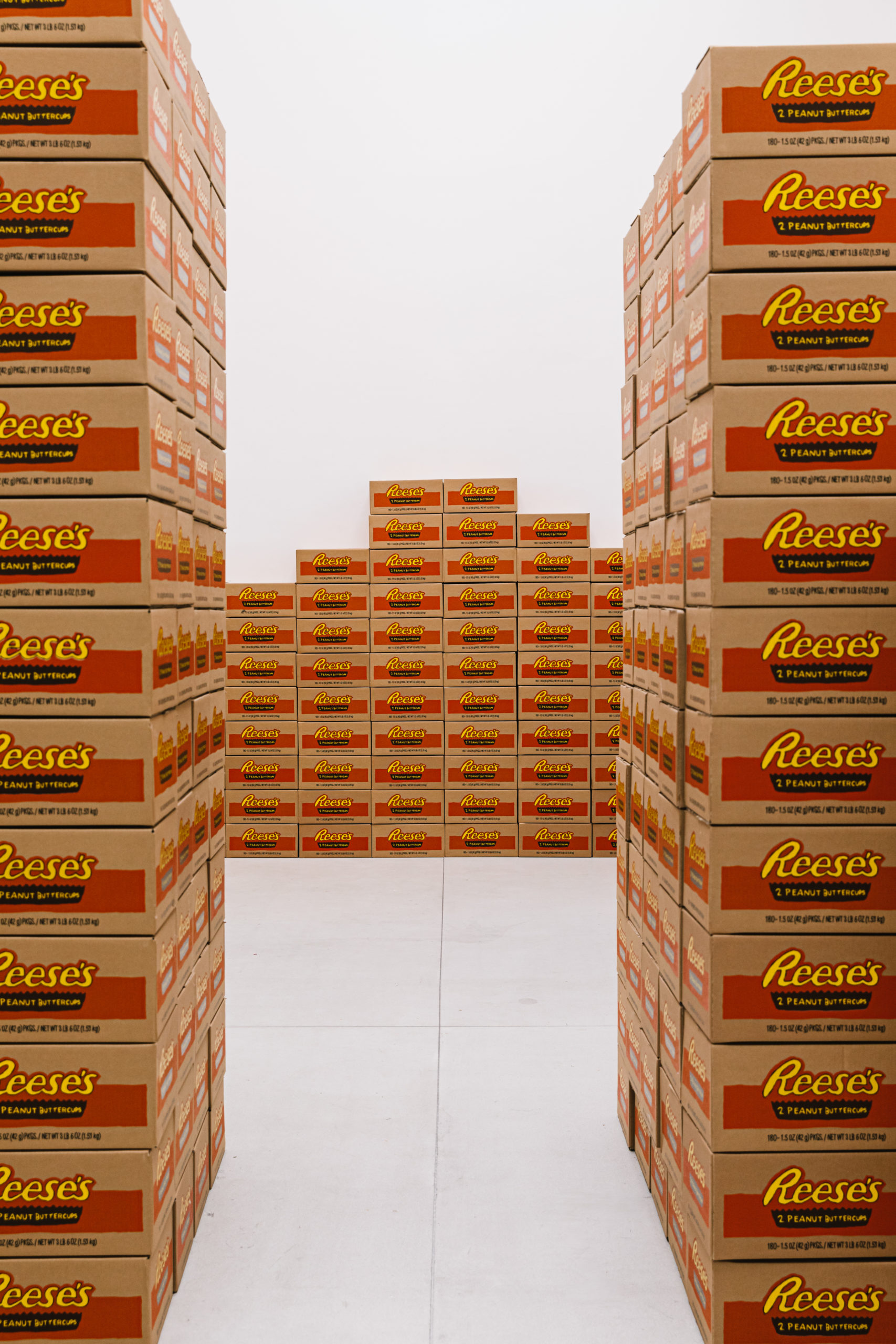 Installation view of “Exchange” by Tom Sachs at Thaddaeus Ropac in Paris (October 2-3, 2021), photo by Karl Hab.
Installation view of “Exchange” by Tom Sachs at Thaddaeus Ropac in Paris (October 2-3, 2021), photo by Karl Hab.
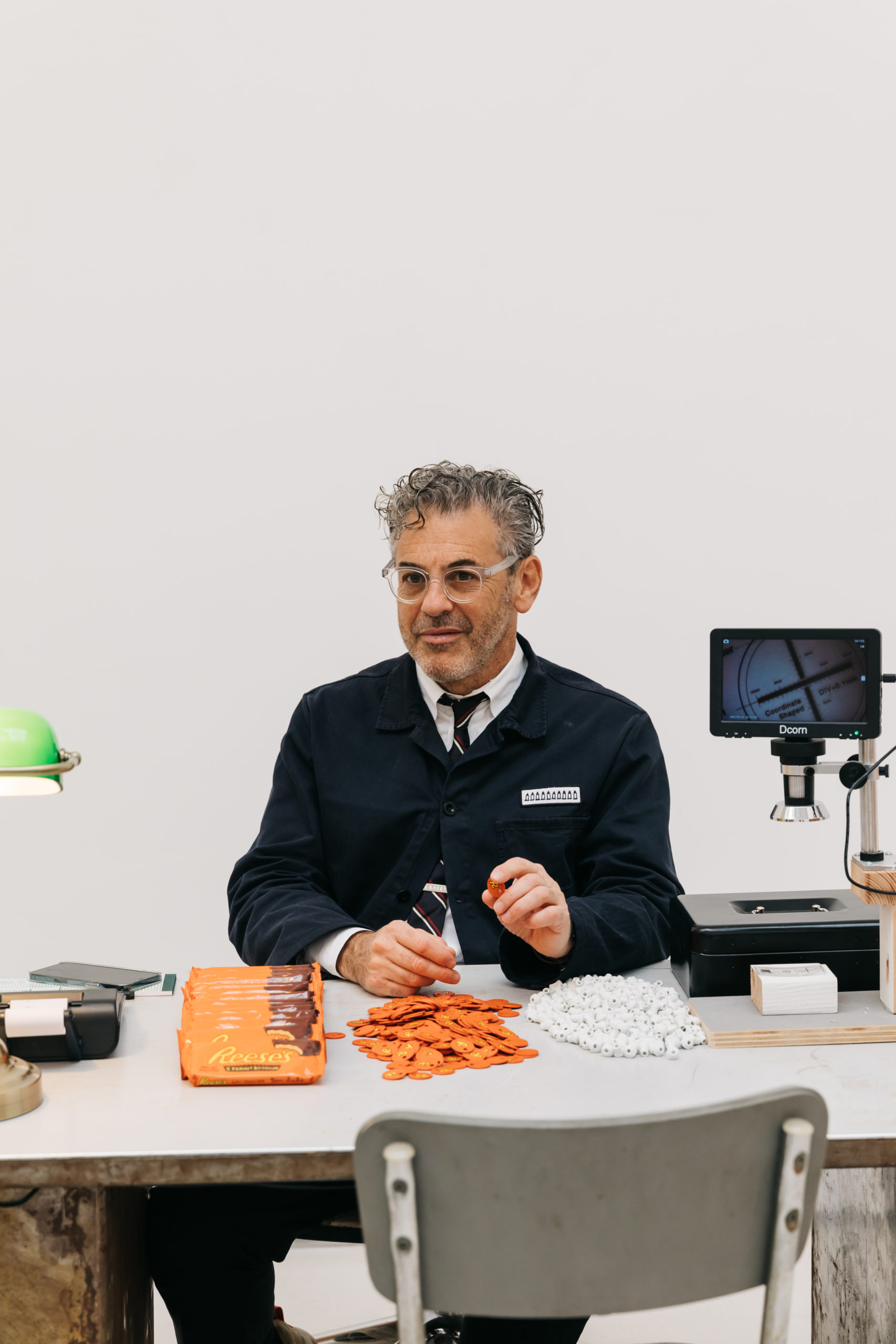 Tom Sachs at “Exchange” at Thaddaeus Ropac in Paris (October 2-3, 2021), photo by Karl Hab.
Tom Sachs at “Exchange” at Thaddaeus Ropac in Paris (October 2-3, 2021), photo by Karl Hab.






